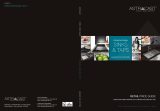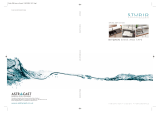Page is loading ...

Foster spa
via M.S. Ottone, 18/20
42041 Brescello (RE) - Italy
tel. +39.0522.687425 - tel. Servizio Assistenza +39.0522.684450
fax +39.0522.686019 - fax Servizio Ricambi +39.0522.962166
e-mail: [email protected]
www.fosterspa.com
INSTRUCTIONS FOR INSTALLATION AND MAINTENANCE
Stainless steel sinks
cod. 9606801

Istructions for the installation,
use and maintenance of
kitchen stainless steel sinks
Sinks’ material: austenitic stainless steel AISI 304 - 18/10
UNI EN 13310:2004
(kitchen sinks for domestic use, functional features and tests’ methods)
INSTALLATION
Standard and at (3 mm bended) edge
Before making any cut-out on the worktop, we suggest to verify and lay the sink on the
worktop itself and/or on the cabinets in order to verify that the external dimensions of the
bowls are compatible with the cabinets themselves, in order to avoid making cut-outs for
sinks that cannot be installed.
We also recommend to verify the possibility to install taps and other accessories, by
checking the place they need and the place that remains. Also verify the possibility to
accede to the water main tap under the sink, and that the positioning of the siphon is
feasible. To install the sink, one must make a cut-out on the worktop according to the
template included in the packing.
Once the cut-out is made, one must position the gasket around the perimeter of the
hole. Before installing the sink, please position the waste-fitting and overflow pipe (when
present); when available, also the command of the autiomatic waste-fitting must be
installed at this stage. Make
sure that the external edge
of the sink is positioned
upon the gasket, so as to
create a barrier preventing
the infiltration of water
and dirt between sink and
worktop.
'PTUFS

After having positioned the sink on the worktop, fix it by tightening the screws of
the brackets which are provided (the screws must be tightened just enough to have
the brackets clamp down on the worktop).
Afterwards, remove the excess gasket with a
cutter. The taps can be installed before or after
the positioning of the sink.
After having installed the sink, connect the
waste-fitting with the siphon. Check the water-
tightness by closing the basket of the waste-
fitting, open the tap and wait until the water
level reaches the overflow; shut the tap, and
wait several minutes, verifying that the water
does not drain away. Empty the sink.
Flush-mount edge
For a correct installation of the flush-mount sinks, please follow strictly the technical
sheet (template) provided with the sink; only qualified personnel should make the cut-
out, and a computer-operated machine is necessary. It is advisable to accurately clean
the seat for the cut-out, and to insert the gasket which is provided, between the sink and
the worktop, so as to avoid possible water infiltration into the worktop or the cabinets.
The work must be carried out by experienced personnel.
Do not use electric screwdrivers to tighten the brackets.
The tightening torque must not exceed 60 N/cm.
It is advisable to install the flush-mount sinks on hydro
repellent materials, in order to avoid eventual deformations
of the material itself.

Undermount installation
For the undermount sinks, proceed as for the normal built-in sinks.
Make a cut-out on the worktop following the template and/or instructions provided with
the sink. Before installing the sink, seal with silicone. Tighten the brackets.
Fixing bracket
system
lateral section
Fixing system
xed bracket
sliding bracket
xed bracket
xed bracket
FR FI
FIS
Fixing bracket for
undermount sinks
20
37

'PTUFS
via M.S. Ottone, n. 18/20 - 42041 Brescello (RE) - Italia
CARE and MAINTENANCE
The Foster collections are the result of a huge experience, and a careful development
to meet at best the necessities of the users’, so as to obtain a high-quality product. It is
important, however, to inform our customers that one must also use the product correctly
and maintain it properly.
As all materials, also stainless steel can become dirty; by following very simple
instructions, one can bring the sink back to its original shine.
For everyday’s maintenance, wash the sink with water and soap, or a product to wash
the dishes, rinse abundantly, and do not forget to dry. For more obstinate dirt, the STEEL
CLEAN line of products, proposed by Foster and available at all our Assistance Centres
throughout the Country, is very suitable to eliminate it without much fuss. Take care
to avoid shocks, to drop heavy objects on the sink, and not to use utensils which can
scratch the surface. Also avoid the contact with chemicals, cleaners for metal, products
to take off paint, metal brushes. Do not leave for long stretches of time tomato residues
on the sink, as well as milk, and coffee on the sink; also, avoid long contacts with metal
drums with wet bottoms, and iron objects in general. Please note that the long contact of
any of the above-mentioned substances with the sink can originate a corrosive attack of
electrochemical nature, even though very mild.
ATTENTION
•
Rinse accurately after use, and dry with a clean cloth
•
To clean the sink, normal detergent can be used, as long as not containing hydrochloric Acid
(commercial Muriatic acid) or its derivates
•
In case of persistant staine, try to clean with some warm vinegar or with specific products for
Stainless steel (the specific line of products “Foster Steel clean” is suggested)
•
Do not use steel sponges to clean the sink, or any other item that could scratch the surface
•
Avoid using muriatic acid or bleach
•
Do not leave iron objects on the sink for long
•
Please keep this instructions leaflet
/


